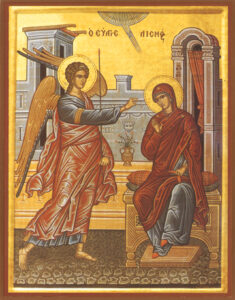
I can think of three possible ways this article might go:
1 I knew a young Protestant couple who were interested in Orthodoxy. They saw that a local Orthodox church was having services on the Friday evenings of Lent, so they went to check it out. The priest met them at the door and welcomed them, saying “Come on in. We’re just about to have a service of hymns to the Mother of God.” As soon as he turned his back, they ran away – literally ran away, they say! He, by the way, is now an Orthodox priest.
2 When I was Anglican, the days of Lent and Holy Week were all violet, dark through and through, with the a exception of one Mass for the Annunciation. Otherwise, there was not a single break till we came to Easter. We were supposed to be downcast till Christ arose. When I became Orthodox, scarcely had Lent begun when here came the first of a series of Fridays with their beautiful, uplifting service of hymns to the Mother of God – and I, the priest, was supposed to vest in blue. Originally that made no sense to me at all. But now it does.
3 The Kontakion for the Annunciation, which is sung also at the Akathist Services and at every Sunday Divine Liturgy during Lent, begins “To you, our champion and leader, we your servants offer thanks for victory, O ….” Who is this addressed to? We might expect it to be Christ the Lord, or perhaps to Saint George or to the warrior archangel Michael. But no. It’s addressed to the “Theotokos”, Mary. How did that small-town teenage girl turn into this?
Let’s take these one by one. There may not be enough time to cover it all today. We’ll see.
1 Mary, Mary, and more Mary
The young couple I mentioned above were certainly not alone in their reaction.
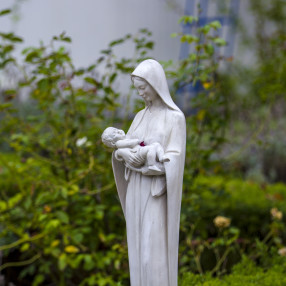
When I first began looking at Orthodoxy, I was startled. As a “high church” Anglican, I was accustomed to the Virgin Mary. We kept her feasts. We often had statues of her with candles burning before them. According to the 1979 Prayer Book, in Eucharistic services we were allowed to commemorate her like this: “Rejoicing in the fellowship of [the ever-blessed Virgin Mary, (blessed N.) and] all the saints…” (Cautiously phrased, I must say.) Unofficial little Anglican prayer books made a great deal more of her…
…but nothing like this! At the end of almost every Orthodox liturgical prayer, we hear “Commemorating our most holy, pure, blessed, and glorious Lady, the Theotokos and ever-virgin Mary, with all the saints…” Over and over again. I suspect most Protestants, ever on guard against idolatry, tend to hear this and nothing else. “But all you talk about is Mary!” That, of course, is not true, but we certainly commemorate her a whole lot.
And then came the Lenten Akathist Hymn. (“Akathist” is Greek for “not sitting” – i.e. we stand for it.)
For any of you who don’t know, on the Friday evenings * of Great Lent we sing I-won’t-even-try-to-count-how-many praises to the Theotokos. The overall theme is the Incarnation of Christ, its origin and immediate aftermath.
- I believe the Slavic tradition varies somewhat.
Here are only four verses:
“Rejoice, unfading rose.
Rejoice, the only one who budded forth the unfading apple.
Rejoice, birth-giver of the fragrant balm of the King of all.
Rejoice, O unwedded Bride, the world’s salvation.”
And this went goes and on and on.
This is sung by the Readers of Holy Resurrection Orthodox Church (location?), from their CD “Ray of the Spiritual Sun” (taken rom “Orthodox Christian Chants” site)
The full Akathist Hymn is much longer. In my opinion the little choir above sings it somewhat too rapidly. This is too beautiful to hurry through. Every lovely line should be savored.
Is this indeed excessive devotion to the Theotokos? The comment of one of my Anglican seminary professors to some of his very Protestant-minded students comes to my mind: “If some devotion to the Blessed Virgin is excessive, the proper correction is not to kick her in the shins!”
However, I have come to see that we Orthodox do not over-do it – not that what I think makes any difference to the Tradition of the Church!
In Arabic. The chanting begins at about 2:15.
In the first place, we keep things in proportion. Our prayers to God the Holy Trinity, and to God the Father, and to Christ our God, and to God the Holy Spirit, vastly outnumber our praises of the Theotokos.
Second, there are Akathist hymns not only to the Mother of God, but also to most of the saints – and I wish we made better use of them. Presently I am daily (or almost daily) praying the Akathist to Saint Nicholas.
And in the third place, Orthodox (and Roman Catholics) can’t even comprehend what the problem is here. I mean, I had a great mother, and you can praise her as much as you want, so far as I’m concerned. Would that offend me? Would it have offended my father? Of course not. So when we come to the extraordinarily great Mother of God, I think her Son Jesus would say, “Praise away, brothers and sisters. You cannot give her too much attention. It makes Me happy.”
Our reasons to praise her have been amplifed in the life of the Church over the centuries. The Mother of God has been responsible for so many miracles, has been seen so many times, has had so many weeping icons, has become such an integral part of Church “family life”. Father Schmemann wrote that if we just hang around the Church for a while, in one way or another she makes her presence known to us.
I think I once told you this story: * When the mother (grandmother?) of a Greek man in our parish was a little girl she woke one night to see a woman in bright light standing at the foot of her bed. Terrified, she ran to her mother, who said “Oh, it’s just the Panaghia. She won’t hurt you. Go back to bed” – and her mother just rolled over and went to sleep.
- Keep in mind here that a popular Greek title for Mary is the “Panaghia”, “all holy”, “most holy” from the common ascription I quoted above.
Orthodox (and Roman Catholics) come at it from the other direction. When they discover that Protestants pay little or no attention to Mary, they are genuinely shocked: “What do you mean, ignoring Mother?”
Before I forget let me tell you the origins of the Akathist Hymn. The following is taken from The Greek Orthodox Christian Society:
“There are many varied stories as to the origins of the Standing Praises to the Theotokos, or Akathist Hymn, but the sources seem to agree that it began in the reign of the Byzantine Emperor Heraclius, in 626 AD. The city of Constantinople, the capital of the Byzantine Empire was unusually free of defence that year. The emperor had taken almost all the soldiers into the East where he was defending the empire from the unceasing attacks by Persian troops. This was a necessary strategic move, but it left Constantinople open to attack – and it was attacked by the Avars, nomadic tribes from the Russian steppes. For months, the people of Constantinople were under siege, forced behind the city walls by enemy ships in the harbour and enemy soldiers on land. Their sources of food began to dry up and the people knew that they were outnumbered, and desperate.
Patriarch Sergius of Constantinople, along with the clergy, took up an Icon of the Theotokos and began to march along the city walls, chanting and censing. They were not expecting a miracle, only hoping to bolster the spirits of the people. However, before the eyes of the City, a miracle occurred. In the bay of the Golden Horn, filled with enemy ships, a tornado appeared. The ships were torn to pieces, and the remaining attackers fled for their lives.

Above: courtesy of Holy Protection of the Mother of God Orthodox Church, Houseton, Texas
The Patriarch led the people into the small Church of the Theotokos at Blachernae, on the Golden Horn. Here they prayed all night. Their gratitude made it possible for them not only to chant praises to Panagia without sleeping, but also to stand for the whole night. Some of their praises still appear in our Akathist Hymn, but most were composed by St Romanos the Melodist many generations later. If there is one theme to the Akathist, it is to ‘Rejoice!’ – the timeliest reminder of all during the period of Great Lent.”
2. But why the joyful Akathist Hymn during the middle of Lent?
The Feast of the Annunciation to the Virgin Mary falls in the middle of Lent – March 25, nine months naturally (supernaturally!) before the feast of Christ’s Nativity. But why give special emphasize to this joyful event during Lent? Because Lent is not intended to be a gloomy time. We are moving out of the darkness of winter towards the light of spring, towards the Resurrection. Repentance is not a sad thing but a joyful thing, as we turn away from sin towards new life in Jesus Christ.
The beginning of these good things was the Annunciation to the Virgin Mary by the Archangel, and her obedient, faithful, courageous “Let it be to me as you say”.
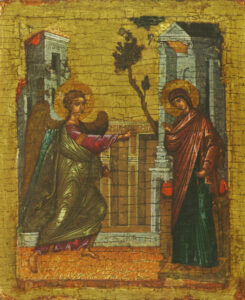
3 Mary our Champion
Orthodox Christians certainly honor the Virgin Mary above all as the Theotokos, “she who gave birth to God”. In fact in icons she is rarely portrayed without her divine Son.
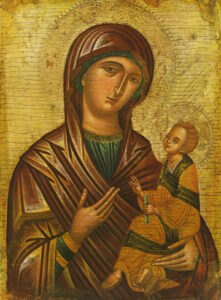
However, sometimes we portray her like this. This is from the rebuilt Saint Nicholas Greek Orthodox Shrine Church in Manhattan (once destroyed in the Twin Towers disaster): The Theotokos, Protectress of New York.
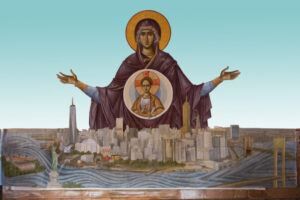
What do you think of it? (I’m awed by it.) Here, too. she is presenting Christ to the world.
You say you want more traditional?
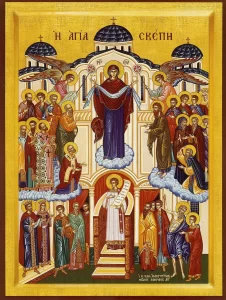
Here is the full text of the Lenten hymn * which I began to quote at the beginning of this article (which, like most things Orthodox, comes in many English translations): “To You our Champion and Leader, we your servants offer thanks for victory, O Theotokos. You have delivered us from every terror. Since you have power invincible, free us from every danger, that we may cry out to you: Hail, O Bride without bridegroom!”
- Kontakia were originally long hymns which combined teaching with praise. Only the refrain remains today. (People had time to listen to long hymns back then, and apparently also the interest.)
How did Orthodox Christians come to look at the Mother of God in this way? I was about to say “not from the Bible”, but if I had said that I’d be wrong. Read this:
“Now a great sign appeared in heaven: a woman clothed with the sun, with the moon under her feet, and on her head a garland of twelve stars. Then being with child, she cried out in labor and in pain to give birth. And another sign appeared in heaven: behold, a great, fiery red dragon having seven heads and ten horns, and seven diadems on his heads. His tail drew a third of the stars of heaven and threw them to the earth. And the dragon stood before the woman who was ready to give birth, to devour her Child as soon as it was born. She bore a male Child who was to rule all nations with a rod of iron.” Revelation 12:1-5
Scriptural imagery can have more than one layer of meaning. The great dragon seems to be the Roman Empire trying to destroy the Woman who is the Church. But the Church didn’t give birth to Christ. The Virgin Mary did. How can John have written this without thinking first of the Woman whom Christ gave into his care, who literally, physically gave birth to the “male Child who was to rule all nations”. In this case the dragon seems to be Herod.

So here is the Virgin Mary, now in Heaven, clothed with the light of her Son, with the lower earthly world at her feet, adorned with the twelve Apostles. And that, I think, is the beginning of how we came to see Mary as Queen of all.
The rest has followed because of her not-infrequent appearances in history, whether in driving off the physical enemies (as in the story ‘way above) or spiritual enemies, or for me, at the moment (did I tell you this last week?) giving me strength and calm at a time when I need it. I look at her icon, and I can feel it flowing out from her.
Or to go back to her most important role: It was she who through her courage and strength allowed the Incarnation to take place, so that in the End Satan’s dark Kingdom below was conquered, and here on earth that dark Lord faces the beginning of his destruction. * Without her “let it be to me as you say”, none of this would have happened. We would still die – and that would be it. Our hope hung on her. Could God have done it another way? That’s a pointless question. All we know is that He did it through her.
- Please, Lord, may it come soon. Please, dear Mother, urge your Son to get this moving. The world is still such a mess, and so are we.
That is the reason why the Creed in its original form, as we Orthodox still say it without alteration, gives her equal credit with God: Christ “and was incarnate of the Holy Spirit and the Virgin Mary…”
So all that explains, I think, how that small-town girl became the Queen Mother. No, sweet gentle Mary here. She bravely said “yes” to to Gabriel, when she had no idea what it would all come to. She rode a donkey sixty miles to Bethlehem while she was pregnant. She gave birth to her Son in a cave. As a new teenage mother, she spent years as a refugee in Egypt. The Virgin Mary was tough.
At Cana of Galilee, she pushed her Son into working a miracle * – and I assume she’s still doing that sort of thing
- He to her: “Mother, this isn’t the right time for Me to do this.” She to the servants: “Do whatever He tells you.” And He did!
That is why we sing:
Sung by the Boston Byzantine Choir, from “Orthodox Christian Chants” site, which contains much quality Orthodox music: https://www.youtube.com/@orthodoxchristianchants5006
Next Week: Saint Joseph the Hymnographer – how to make lemonade out of lemons
The following week: We begin our annual Holy Week posts, beginning on March 7, the Eve of Lazarus Saturday.
Dear Father,
I don’t mean too offend you, but I was taught that the
akathest hymn we sing to the Theotokos during Holy week,vwas composed by
St. Kassia. We may be thinking of two different hymns. At St. Nicholas Church there is an icon of St. Kassia, on the East wall, and it depicts her writing a hymn. In Greek it says the hymnographer.
It takes more than that to offend me, ma’am! Yes, we have two different hymns here.
1) At Holy Wednesday evening Bridegroom Orthros (Matins), the beautiful Kassiane Hymn is sung to Jesus Christ. It was composed by the Nun and Hymnographer Kassiane, using words she placed into the mouth of the “sinful woman” who anointed His feet and His head.
2) On Lenten Friday evenings the Akathist (or Akathistos) hymns are sung the to Mother of God.